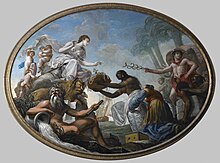Spiridione Roma

Spiridione Roma (Greek: Σπυρίδων Ρώμας (1737–1781), also known as Spiridon or Spyridon Romas, was a Greek-Italian painter, best known for his work in England.[1][2][3]
Biography[]
He was born in Corfu, then a territory of the Republic of Venice. Little is written about his biography and training. He is best known for an allegorical ceiling piece, The East Offering its Riches to Britannia (1778), commissioned by the East India Company for the Revenue Committee Room in the East India House in London.[4] The painting generally represents the era's panegyric to Britain's imperial and colonialist domination.[5] The painting is described in Gentleman's Magazine (1778) as follows:
The principal figure represents Britannia seated on a rock, to signify the firmness and stability of the empire; and as guardian and protectress of the Company, who are denoted by children behind Britannia, and overshadowed by her veil. The union of the old and new Companies is expressed by two children embracing each other, and one of them placed sitting on the upper part of the rock, to show the firm basis on which the present Company stands; on the other part of the rock the child climbing up towards the summit is intended to express the prospect of the Company’s continuance.
Britannia is characterised by the usual emblems of the shield and spear, and guarded by a lion, which lays tamely by her side, pleased with the offerings made her from the different East-Indian provinces. At the foot of the rock lays the genius of the Ganges, in a majestic attitude, pouring out his whole stream on Britannia’s footstool. The various provinces are represented under the Conduct of Mercury, the god of merchandise, eagerly pressing to deposit their different produce and manufactures before the throne of Britannia. Calcutta (the capital settlement of the Company in Bengal) presents a basket with pearls and other rich jewels, which Britannia receives. China is characterised by jars of porcelain and chests of tea; the produce of Madras and Bombay by a corded bale; Bengal is denoted by an elephant, palm-trees and a camel.
Persia appears at a distance bringing silks, drugs, and other effects, and with her are to be supposed all the rest of the provinces; which the artist could not describe on the canvas without crowding or destroying the whole composition, and harmony of the picture. At a distance is an Indiaman under sail, laden with the treasure of the East, an emblem of that commerce from which both Britain and the Company derive great and singular advantages.[6]
The painting is now in the Foreign and Commonwealth Office in London.[7] A reproduction is held in the British Library in London. Other works by Roma in the British National Trust collections include An Illusionistic Gothic Patron's Pew, in the Extension of the Chapel (c.1769/1771).[8]
References[]
- ^ Drakopoulou, Eugenia (2016). Pittura Romeica in Italy: Artistic transfers across the Adriatic sea (18th - 19th centuries) Volume 13. Athens GR: National Hellenic Research Foundation. pp. 17, 20.
- ^ Hatzidakis, Manolis & Drakopoulou, Eugenia (1997). Greek painters after the fall (1450-1830) Volume B. Athens GR: Center for Modern Greek Studies E.I.E. pp. 205–208.
- ^ Editors Corfu Museum (August 6, 2021). "The unknown great Corfiot-European painter Spyridon Romas". Corfuland. Retrieved August 6, 2021.CS1 maint: extra text: authors list (link)
- ^ Gentleman's Magazine 48 (1778), 628-29.
- ^ The Ideologies of the Raj, Cambridge, page 18.
- ^ "Genetleman's Magazine". 48. 1778: 628–29. Cite journal requires
|journal=(help) - ^ The painting is discussed in Phiroze Vasunia, ‘Memories of Empire', in the Oxford World History of Empire, vol. 1: The Imperial Experience, edited by Peter Fibiger Bang, C. A. Bayly, and Walter Scheidel (Oxford, 2021), pp. 497–522.
- ^ The History and Antiquities of London, Westminster, Southwark, and Parts Adjacent, page 492.
- 1731 births
- 1787 deaths
- 18th-century Italian painters
- Italian male painters
- Italian Baroque painters
- 18th-century English painters
- English male painters
- 18th-century Greek painters
- Italian painter, 18th-century birth stubs
- English painter stubs